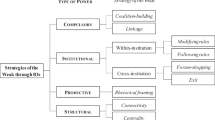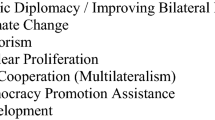Abstract
This paper compares the deterrence provided by a competitive media sector towards government induced corruption with that of a media monopoly in a setting where the media might raise both true as well as false allegations of corruption. It finds that competition’s impact on corruption deterrence is not necessarily better than a monopoly but rather hinges on a delicate balance between government’s kickback from corruption and the media’s potential benefit from exposure. While the paper does identify conditions in which a competitive media sector would improve upon the deterrence provided by a monopoly, it also find conditions under which it would do no better than a monopoly and in some situations its strategic response could be even worse especially when it intensifies effort towards justifying false allegations.
Similar content being viewed by others
References
Albats Y. (1999) Reporting stories in Russia that no one will publish. Nieman Rep 53, 25–26
Banerjee A. (1997) A theory of misgovernance. Q J Econ 112(4): 1289–1332
Bardhan P. (1997) Corruption and development: a review of issues. J Econ Lit 35(3): 1320–1346
Besley T., Burgess R. (2001) Political agency, government responsiveness and the role of the media. Eur Econ Rev 45(4–6): 629–640
Besley, T., Prat, A. Handcuffs for the grabbing hand? Media capture and government accountability. C.E.P.R Discussion Paper 3132. London Centre for Economic Policy Research (2002)
Besley T., Burgess R., Prat A. (2002) Mass media and political accountability. London School of Economics, mimeo, London
Cadot O. (1987) Corruption as a gamble. J Pub Econ 33(2): 223–244
Clark D., Riis C. (1998) Contest success functions: An extension. Econ Theory 11(1): 201–204
Darby M., Karni E. (1973) Free competition and the optimal amount of fraud. J Law Econ 1, 67–88
Da Silva C. (2000). Journalism and corruption in Brazil. In: Tulchin J., Espach R. (eds). Combating corruption in Latin America. Woodrow Wilson Center Press, Washington, DC
Daughetty A., Reinganum J. (2000) On the economics of trials: adversarial process, evidence, and equilibrium bias. J Law Econ Organ 16(2): 365–394
Djankov S., McLiesh C., Nenova T., Shleifer A. (2003). Who owns the media. J Law Econ 46(2): 341–381
Farmer A., Pecorino P. (1999). Legal expenditure as a rent-seeking game. Pub Choice 100(3–4): 271–288
Grossman G., Helpman E. (1996) Electoral competition and special interest politics. Rev Econ Stud 63(2): 265–286
Hirshleifer J., Osborne E. (2001) Truth, effort and the legal battle. Pub Choice 108(1–2): 169–195
Kadane J., Schum D. (1996) A probabilistic analysis of the Sacco and Vanzetti evidence. Wiley, New York
Lacy S. (1987) The effects of intracity competition on daily newspaper content. Journalism Q 64, 281–90
Laffont J., Tirole J. (1993) A theory of incentives in procurement and regulation. MIT, Cambridge
Litman B., Bridges J. (1986) An economic analysis of daily newspaper content. Newspap Res J2, 9–26
Marjit S., Shi H. (1998) On controlling crime with corrupt officials. J Econ Behav Organ 34(1): 163–172
Mauro P. (1995) Corruption and growth. Q J Econ 110(3): 681–712
Mauro P. (1998) Corruption and the composition of government expenditure. J Pub Econ 69(2): 263–279
Mookherjee D., Png I.P.L. (1995) Corruptible law enforcers: How should they be compensated. Econ J 105(428): 145–159
Robson, A., Skaperdas, S. Costly enforcement of property rights and the Coase theorem. CESifo working paper 762. Munich: CESifo 2002
Rose-Ackerman S. (1999) Corruption and government: causes, consequences and reform. Cambridge University Press, New York
Schmalensee R. (1978) A model of advertising and product quality. J Polit Econ 86(3): 485–503
Skaperdas S. (1996) Contest success functions. Econ Theor 7(2): 283–290
Skaperdas S., Grofman B. (1995) Modelling negative campaigning. Am Polit Sci Rev 89(1): 49–61
Stapenhurst R. (2000) The media’s role in curbing corruption. Working paper. World Bank Institute, Washington
Stromberg D. (2001) Mass media and public policy. Eur Econ Rev 45(4–6): 652–663
Vaidya, S. Corruption in the media’s gaze. Euro J Poli Econ (inpress) (2005)
White A., Andsager J. (1990) Winning newspaper Pulitzer prizes: the (possible) advantage of being a competitive paper. Journalism Q 67(4): 912–919
Author information
Authors and Affiliations
Corresponding author
Rights and permissions
About this article
Cite this article
Vaidya, S. The Nature of Corruption Deterrence in a Competitive Media Sector. Economics of Governance 7, 229–243 (2006). https://doi.org/10.1007/s10101-006-0010-3
Received:
Accepted:
Published:
Issue Date:
DOI: https://doi.org/10.1007/s10101-006-0010-3




